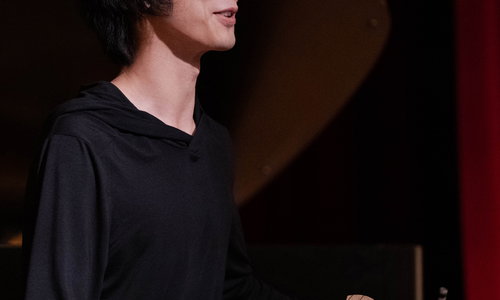Form, Space, Resonance
Details
Peter Ko full profile / Solo Cello / 1 musician
Full program notes
Woodycock (ca. 1580) - Anonymous
Captain Hume's Pavan (p. 1605) - Tobias Hume
Projection 1 (1950) - Morton Feldman
Captain Hume's Galliard (p. 1605) - Tobias Hume
Intersection 4 (1952) - Morton Feldman
Sept Papillons (2000) - Kaija Saariaho
Suite à Violoncello Solo senza basso, No. 1 in G Major, BWV 1007 (ca. 1717) - Johann Sebastian Bach
=========
The magic of music, of sound, lies in part from how it emerges out of seemingly simple seeds and premises--a single note, a single string, a single instrument, in a singular space. And yet, what emerges out evokes a sense of infinite possibilities, outwards in terms of how the music can evolve, and inwards in terms of how we deepen our perception to the sound, the space, and the present moment of materialization and realization of the music as it unfolds.
This program centers around this, exploring aspects of form, space, and resonance, framed through the solo cello in performance. The program starts with "Woodycock", an anonymously-composed Jacobean Renaissance tune. It is a relatively simple piece of music, with its melody evoking the soft cooing of an English wood dove--simple in all of the best senses of the word. From this melody, unfolds a set of variations, modest in scope, sincere in its affect.
Featured are two pieces by Tobias Hume, a Pavan and a Galliard; a popular pair of dances in the Renaissance times, with a Pavan being a sort of regal, processional dance, followed by a Galliard being much lighter and energetic in its poise. Hume used the form of these dances to showcase the capabilities of a solo bowed stringed instrument--he went against popular belief of the time, and contended that such an instrument was worthy and could rival the lute/keyboard in the trinity of Part, Division, and Passion.
Interspersed with the Hume pieces are two pieces for solo cello by Morton Feldman. These are relatively early works by Feldman, and are unusual in his oeuvre because of the fact that these were graphic scores. Clearly marked are exactly when the sounds must occur, whether or not the sounds were bowed, harmonic, or pizzicato, and whether or not the sounds must be low, middle, or high in terms of register. Otherwise, the choice of pitch is entirely up to the performer--it is up to the cellist to follow this form and fill it in according to what makes sense with the materiality of the instrument.
The Feldman pieces can be related to the ideas circulating in the cultural milieu of the time, especially that of visual art. With "Projection 1", we can think of it being much like Helen Frankenthaler's paintings, where the canvas is not prepared so that paint sits on top of it, but rather is untreated, and the paints are allowed to soak into the canvas, bleeding into its "space". Following this analogy, we can think of "silence" as the canvas, the natural acoustic properties of the room as the "canvas", in which these singular notes ring out, emerge and fade out, harkening a sense of velvety texture like what Feldman adored as luxury.
In contrast, "Intersection 4" is much more like that of Jackson Pollock, where paint on canvas is no longer about creating representations of figures and ideas, but as a direct result of an intensely controlled gesture, where one can see the energy of movement being manifested in paint. "Intersection 4" then turns this canvas of "silence", not as plush velvet, but like that of an electric field, where notes burst out in a highly energized frenzy, cutting out just as abruptly as they erupt.
Saariaho and Bach's pieces for solo cello possess a rare intrinsic quality of how they seem to emerge out of the natural resonant properties of the cello. Saariaho in particular was a composer closely associated with "Spectralism", a type of music that was interested in studying the resonant properties of sound itself and composing accordingly. "Sept Papillons", which translates to "Seven Butterflies", is extraordinary in how Saariaho works with the harmonic extremes of the cello, of harmonics, timbral shifts, and noise, to create seven distinct aural images of butterflies--we think of butterflies as being delicate and ethereal, but one must never forget the idea of the "butterfly effect", in where the flap of their wings can eventually lead to the manifestation of a tornado.
Bach's first solo cello suite is perhaps the simplest of the six suites, and yet, in many ways, remains one of the most "natural" in terms of how it plays out. On most cellos, the open G string is the most resonant string of the four--there is no doubt in my mind that this natural acoustical phenomenon is what guided him to start with that very same note. From that open G, we are treated to an unfurling of counterpoint that harmonizes perfectly, yet inventively with that centering resonance. Like the "Sept Papillons", the first suite features seven movements.. and like the Hume, they take on dance forms popular of the time, to fill in and expand with the aural properties and possibilities of the instrument.
Videos from this player
Other programs from this ensemble
i/0 SQ: Britten and his Influences
- Musician profile: Peter Ko
-
Instruments: String Quartet
- Musicians: Peter Ko, Jesus Cervantes, Amir Nouroz Nasseri, Myra Hinrichs
Redwood Piano Trio: Schumann, Dvorak
- Musician profile: Peter Ko
-
Instruments: Piano Trio
- Musicians: Peter Ko, Lauren Basney, Byron Chow

 Continue with Facebook
Continue with Facebook
 Continue with Google
Continue with Google
 Continue with Apple
Continue with Apple

